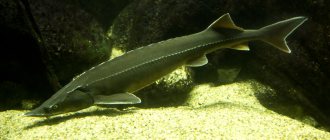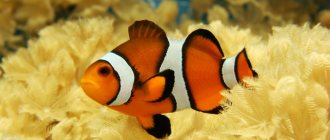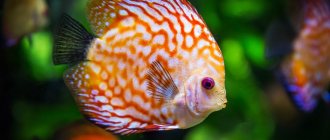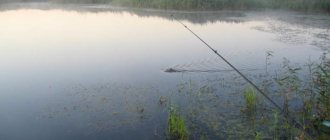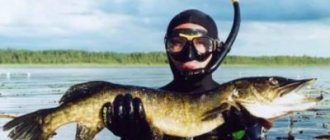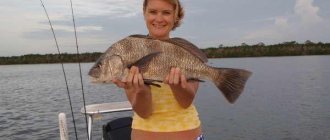In the wild, the Amur sleeper lives in eastern Russia, in the waters of the Amur and the rivers flowing into it, small lakes and creeks. This is where another name for the fish came from - “Amur goby”. Under natural conditions, some individuals grow up to 20-22 cm, but in an aquarium, fish rarely reach 10-12 cm in length. The average size of an adult in a home aquarium is 8 cm.
The large head with the lower lip protruded forward and the mouth slightly open determined the popular name of the fish. The round, thick, almost rigid body ends in a round caudal fin. The dorsal fin is double, with the rear fin in males being much larger than the front. The main background of the body is brownish-gray; large brown-black spots are scattered across it, forming a carpet pattern. During the spawning period in males, these spots become black, and the spaces between them form a complex pattern that glows in the reflected light with a bluish sheen. The pectoral fins of the Amur goby form a kind of suction cup, which allows this fish to attach to any surface with its help.
Amur gobies living in natural conditions are paler in color than their aquarium relatives. In addition, they are more sensitive to the oxygen content in the water.
Rotan is exceptionally unpretentious and undemanding; it lives well even in small cold-water aquariums (from a bucket for a couple of fish). Tolerates oxygen deficiency in water. In the wild, the Amur goby, like golden crucian carp, can withstand almost complete drying and freezing of water bodies, burying itself in silt.
There are no special requirements for keeping Perccottus glenii in a home aquarium, except that when decorating the aquarium internally, you should take into account that the goby loves shelter. The size of the container when keeping these fish is not critical, but it is desirable that there be at least 10 liters of water per individual. The presence of aquatic plants is also desirable. When kept in an aquarium, it should be taken into account that the Amur goby is a predatory fish that attacks other representatives of the aquarium fauna. There have been cases when these gobies attacked fish of other species that were not inferior to them in size. Rotans should absolutely not be placed in the same aquarium with small decorative fish. In a day or two, the Amur goby is capable of catching all small animals such as guppies and neons and simply gobbling them up.
These gobies are very voracious and in an aquarium they eat almost any live food (bloodworms, tubifex, etc.). In addition, they eat dry granulated food very well. When feeding Amur gobies with small fish, you can observe a peculiar hunting behavior of rotans. Having noticed the fish, rotan, with slow, almost imperceptible to the eye movements of the pectoral fins, without bending the body at all, begins to approach its prey. Swimming up to it at a distance of 8-10 cm, the rotan simultaneously rushes towards the prey with a sharp movement of the pectoral and caudal fins.
In home aquariums, rotans reproduce well. When the spring sun begins to warm the water and growing plants create good aeration in the aquarium, male rotans dress in mating plumage, become pugnacious, and begin to pursue females. Rotans spawn in an aquarium, attaching eggs to the inside of a shelter placed in the aquarium. The male carefully guards the eggs and the fry that hatch from them, attacking any fish that swims up to the nest and viciously destroying snails and other aquatic animals that find themselves near the nest.
It is advisable to place the newly born rotan fry (if you need them) in a separate container, because adult fish are not at all averse to feasting on the little ones. The fry feed on zooplankton and other small live food. With plenty of feeding, fish grow quite quickly.
In 1948, biologists from Moscow University brought the rotan firebrand from the Far East. And the next year this fish was already bred by many Moscow aquarists.
By Andshel - Own work, CC BY-SA 3.0
In an aquarium, rotan reaches 10-12 centimeters. The large head with the lower lip protruded forward was the basis for the popular name of the fish. The round, thick, elongated body ends in a rounded caudal fin. Rotan has two dorsal fins, with the rear fin in males being much larger than the front.
Large dark brown spots are scattered across the brownish-gray background of the body, forming a carpet pattern. During the spawning period in males, these spots become black, and the spaces between them form a complex bluish pattern.
Rotan is exceptionally unpretentious and undemanding. It lives well in cold-water aquariums, being content with small (a bucket for a couple of fish) rooms.
Rotans need to be kept separately, as they are predators that attack other fish, sometimes even not inferior to them in size.
By Petrtyl - Own work, CC BY-SA 3.0
When rotans are fed with small fish, you can observe their interesting hunt. Having noticed the fish, rotan slowly, with movements almost imperceptible to the eye, creeps up to its victim. Swimming up to her at a distance of 8-10 centimeters, he rushes forward with unexpected speed and hits almost without missing. Rotan is very gluttonous. In three days he can eat about ten adult female guppies.
Rotans reproduce well in aquariums. When the spring sun begins to warm the water and well-growing plants release a lot of oxygen, the males dress in spawning attire, become pugnacious and begin to chase the females.
For spawning, it is best to place half a flower pot in the aquarium, making a small cave out of it. Rotans will stick eggs to the inside of the pot, after which the female needs to be planted.
The male selflessly guards the nest, viciously attacking any approaching fish. Try sticking a thin stick into the aquarium. As soon as you bring it closer to the nest, the rotan will attack it with ferocity and grab it with its mouth so tightly that it can be pulled out of the water.
By Andshel - Own work, CC BY-SA 3.0
The male is separated from the fry after they have spread throughout the aquarium.
Rotans bred in aquariums were released into several Moscow ponds. There they took root well and multiplied greatly. One-year-old rotans caught from a pond are larger in size than their relatives raised in an aquarium, much paler in color and more sensitive to the oxygen content in the water.
Source: F. Polivanov “Underwater world in the room”
Correct bait for rotan in winter and summer
To find the right bait for rotan, you need to consider its diet in sufficient detail. First of all, he is a carnivore, so he needs meat. It can be chicken liver, crustacean meat, shrimp, minced meat twisted in a meat grinder. In addition to meat, you can also use caviar bags, which can be made from a square of fabric cut from synthetic tights. You can also use regular worms, red worms, maggots and bloodworms. Rotan also bites on such bait with great pleasure. If we take vegetable attachments, then here is a standard “gentleman’s” set: peas, corn and cereals.
As for unnatural baits, this is where bite activators and pheromone-based baits come into play. You can also use rubber worms, artificial bloodworms and maggots. After all, in fact, rotan doesn’t care what bait is on the hook. The main thing is that it does not arouse the slightest suspicion and sways, creating the illusion of a living worm or maggot.
Description of rotan
Starting from the second half of the last century, among foreign and domestic aquarists, rotan often began to be called the Amur goby, which is due to the very characteristic appearance of such a fish.
Appearance
Rotans, or herbaceous plants, have a dense and short body, covered with dull and medium-sized scales. The rotan firebrand has a rather variable color, but grayish-green and dirty brownish tones are still predominant, with the obvious presence of small spots and stripes of irregular shape. The coloring of the belly is, as a rule, inconspicuous grayish shades. With the onset of the mating season, rotans acquire a characteristic black color. The length of an adult varies depending on the basic conditions of the habitat, but is approximately 14-25 cm. The maximum weight of an adult fish is 480-500 grams.
The head of rotans is quite large, with a large mouth lined with small and sharp teeth, which are arranged in several rows. The gill covers of the fish have a spine directed backwards, characteristic of all perch-like fish. The main difference between rotan is the formation of a soft spine-like process and soft fins without pointed spines.
This is interesting! In a sandy reservoir, the scales of the big sleeper sleeper are lighter in color than those of the individuals inhabiting swampy waters. By spawning, around May-July, the male is painted in a noble black color, and the female, on the contrary, acquires lighter shades.
There is a pair of fins in the back area, but the rear fin is noticeably longer. The species feature is represented by a short anal fin and large, rounded pectoral fins. The tail fin of the fish also has a rounded shape. In general, rotans are very similar in appearance to representatives of ordinary gobiids, but have a pair of disproportionately small ventral fins.
Behavior and lifestyle
Rotans are not able to survive complete freezing, but when water freezes, thanks to the glucose and glycerol that are secreted by the fish, the specific concentration of salts in tissues and water increases significantly, which contributes to a significant decrease in the crystallization temperature. Thus, immediately after the water thaws, rotans can easily return to their normal activities.
Perccottus glenii prefers standing water bodies, ponds and swamps. Fish of this species are very unpretentious to external conditions, including oxygen deficiency, but try to avoid bodies of water with fast or moderate currents. The only representative of the genus of firebrands inhabits ponds and is found in small, overgrown and swampy lakes, as well as oxbow lakes.
This is interesting! Rotans are able to easily withstand partial drying out of reservoirs and complete freezing of water to the bottom in winter, and also survive well even in polluted water elements.
Leading a sedentary lifestyle, the fish actively hunts along with other typical ambush predators - hiding in dense underwater thickets. In the last ten days of December, fish form significant accumulations in ice cavities, which are filled with air-ice wet masses. In this state of torpor, the fish spend the winter until spring. In reservoirs near Moscow, rotan firebrands, as a rule, do not hibernate.
Lifespan
The average lifespan of rotan under the most favorable conditions is within fifteen years, but a significant part of individuals live for about 8-10 years.
What to feed rotan in an aquarium
In the wild, the Amur sleeper lives in eastern Russia, in the waters of the Amur and the rivers flowing into it, small lakes and creeks. This is where another name for the fish came from - “Amur goby”. Under natural conditions, some individuals grow up to 20-22 cm, but in an aquarium, fish rarely reach 10-12 cm in length. The average size of an adult in a home aquarium is 8 cm.
The large head with the lower lip protruded forward and the mouth slightly open determined the popular name of the fish. The round, thick, almost rigid body ends in a round caudal fin. The dorsal fin is double, with the rear fin in males being much larger than the front. The main background of the body is brownish-gray; large brown-black spots are scattered across it, forming a carpet pattern. During the spawning period in males, these spots become black, and the spaces between them form a complex pattern that glows in the reflected light with a bluish sheen. The pectoral fins of the Amur goby form a kind of suction cup, which allows this fish to attach to any surface with its help.
Amur gobies living in natural conditions are paler in color than their aquarium relatives. In addition, they are more sensitive to the oxygen content in the water.
Rotan is exceptionally unpretentious and undemanding; it lives well even in small cold-water aquariums (from a bucket for a couple of fish). Tolerates oxygen deficiency in water. In the wild, the Amur goby, like golden crucian carp, can withstand almost complete drying and freezing of water bodies, burying itself in silt.
There are no special requirements for keeping Perccottus glenii in a home aquarium, except that when decorating the aquarium internally, you should take into account that the goby loves shelter. The size of the container when keeping these fish is not critical, but it is desirable that there be at least 10 liters of water per individual. The presence of aquatic plants is also desirable. When kept in an aquarium, it should be taken into account that the Amur goby is a predatory fish that attacks other representatives of the aquarium fauna. There have been cases when these gobies attacked fish of other species that were not inferior to them in size. Rotans should absolutely not be placed in the same aquarium with small decorative fish. In a day or two, the Amur goby is capable of catching all small animals such as guppies and neons and simply gobbling them up.
Range, habitats
Initially, the habitat of rotan was the Amur River basin, as well as the Far Eastern part of Russia, the northern regions of North Korea and the northeastern territory of China. The appearance of this only representative of the firebrand genus in the last century in the Lake Baikal basin is considered by many scientists to be the result of biological pollution.
This is interesting! Today, the presence of rotan is noted in the basins of such rivers as the Volga and Dnieper, Don and Dniester, Danube and Irtysh, Ural and Styr, as well as the Ob, where this fish prefers standing and floodplain reservoirs.
At the very beginning of the twentieth century, rotans were released into the reservoirs of St. Petersburg, but subsequently quickly spread almost everywhere in Northern Eurasia and Russia, as well as many European countries. In reservoirs with established fish communities and a large number of predatory species, there are practically no free food resources. In such reservoirs, rotan firebrands live modestly, mainly near the coastal zone, in plant thickets, so there is no noticeable negative impact on the composition of the ichthyofauna.
Diet, nutrition
Rotans are aquatic predators. If initially the fry use zooplankton for food, then after a while small invertebrates and benthos serve as food for the fish. Adults actively eat small species of fish, leeches and newts, as well as tadpoles. Golovachs are able to feed on the eggs of other fish and even carrion. The species has excellent vision, thanks to which it sees prey from afar, after which it slowly, “dashes”, approaches the victim, working at this moment exclusively with its ventral fins. The movements of a hunting rotan are very slow and calm, and the fish itself is characterized by intelligence, which allows it to make non-trivial decisions in difficult situations.
This is interesting! In rotan, cannibalism is widespread in the form of large fish eating smaller individuals belonging to their own species, due to which the bait is swallowed very deeply during fishing.
In small bodies of water, rotan firebrands very quickly become numerous, and therefore are capable of completely and quite easily exterminating almost all representatives of any other species of non-predatory fish. Rotans are very voracious and often have absolutely no sense of proportion in their diet. When the fish is completely full, it becomes almost three times thicker than its usual state. Sated rotans quickly sink to the bottom, where they can sit for up to three days, trying to completely digest the food.
What does a voracious predator eat?
Rotan is a predatory fish and has terrible gluttony. What does rotan eat in the pond? Its diet is very wide - the fry eat zooplankton, and later small invertebrates. Adults feed on eggs and fry of various fish, leeches, newts, and amphibian larvae. The wide and powerful mouth of the rotan allows it to swallow fish up to 6 cm long. It swallows prey gradually and does not experience any discomfort when breathing. So his own small size does not hinder him in any way. In addition, the fish is capable of swallowing various insects from the surface of the reservoir and looking for larvae in the upper layers of the lake soil.
It is noted that rotan may well eat its relatives. In small bodies of water, predators, uniting in schools, begin a real hunt for other species of fish until they are satiated. Therefore, the question of how to clean a pond from rotan is not at all idle. Having had enough for future use, the fish sinks to the bottom of the reservoir to digest food and remains inactive for some time.
Reproduction of rotan
Amur sleeper firebrands reach full sexual maturity approximately in the second or third year of life. The active spawning period begins from May to July. The average female of the only representative of the firebrand genus is capable of laying up to one thousand eggs. At the spawning stage, males not only turn a characteristic black color, but also acquire a peculiar growth that appears in the frontal area. Females of Perccottus glenii, on the contrary, are characterized by a light, white color during the spawning period, thanks to which mature individuals become very visible in turbid waters.
Rotan eggs are distinguished by their oblong shape and yellow color. Each egg has a thread stem, which ensures a very strong and reliable fixation on the bed. Since all the eggs hang freely and are constantly washed by water, their viability rates increase significantly. All eggs laid by the female are constantly guarded by the male, who is ready to defend his offspring and actively protect them from any other aquatic predators. However, if rotans can quite successfully defend themselves against the encroachments of verkhovka or ruffe, then such an aquatic predator has unequal chances with perch and very often loses.
After rotan larvae begin to hatch en masse from the eggs, quite often the offspring are swallowed by the male himself - this is a kind of struggle of individuals of different ages for survival. Firebrands are able to live even in slightly salted water, but the spawning process can only take place in fresh water bodies. It is very interesting to observe the life, as well as the reproduction and habits of rotan in aquarium conditions. In captivity, the habits of a typical predator appear, which hides among vegetation and attacks its prey with lightning speed.
Important! The optimal conditions for active reproduction of the only representative of the genus of firebrands are the presence of a water temperature within 15-20°C.
Commercial value
Currently, a search is underway for the most effective ways to reduce the population of this aquatic predator. In many pond farms, rotans cause enormous harm, eating eggs and destroying the juveniles of any valuable fish.
The absolutely unique biological characteristics of the sleeper firebrand allowed such a single representative of the firebrand genus to turn out to be a very dangerous invasive species, which in a short period of time colonized and still continues to very actively colonize new bodies of water, even too far from its historical range.
Literary sources note the omnivorous nature of rotans, which actually consume a huge amount of aquatic invertebrates belonging to almost all groups, but preference is given to moving organisms. In the stomachs of adult fish, one can observe the presence of tadpoles, eggs and juvenile fish of various species. In any natural and artificial reservoirs with a high population density, adult predatory fish eat terrestrial invertebrates that fall into the water. It is quite rare to see plant food in the stomachs of such fish.
In addition to excellent taste characteristics and quite decent level of consumer properties, the benefits of rotan meat for the human body are also well known. The beneficial properties of this fish are due to its balanced vitamin and mineral composition, a fairly high content of vitamin “PP”, sulfur and zinc, fluorine and molybdenum, chlorine and chromium, and nickel.
Enemies and rivals of the predator
In large bodies of water, rotan is hunted by about a dozen species of predatory fish. Its main enemies are perch and snakehead, as well as pike, killer whale and catfish. In addition, dragonfly larvae and various aquatic beetles feed on firebrand eggs. In reservoirs where there are more than one or two species of fish, sleeper cannot reach large numbers. And in small, overgrown ponds, where, in addition to rotan, crucian carp and roach live, over time, rotan becomes almost the only inhabitant. Amateur fishermen often use rotan as bait to catch large predators and transport it from one body of water to another. This causes great damage to fisheries. Predators quickly take root and reproduce, eating eggs and fry of valuable fish species. It is no coincidence that many regions have introduced a ban on the use of imported live bait.
Population and species status
Rotans belong to the category of weed fish that can quite actively displace other fish species from a reservoir or sharply reduce their overall population. Now the population of the species is at a very high level, so methods are currently being actively developed to combat the only representative of the genus of firebrands, which causes significant harm to pond and lake farming. In the absence of aquatic predators, sleeper sleepers, as a rule, completely displace fish such as roach, dace and even crucian carp.
Researchers have now found several biological methods to suppress the overall population, including the removal of protective vegetation, traps, periodic collection of eggs on natural spawning grounds and the installation of artificial spawning grounds.
Important! Special fine-mesh protective nets must be installed inside all fish catchers.
A chemical method has also been developed to reduce the rotan population, but the best option at the moment is to use a whole range of basic measures: the use of ichthyocides, treatment of adjacent reservoirs with quicklime and ammonia water, removal of aquatic vegetation, as well as leveling of pond beds for complete drainage of water .
With a significant lack of other types of food, the largest and most well-developed individuals of rotan actively eat the smallest representatives of their species. This is how the population of Perccottus glenii is maintained at stable levels.
Description of the appearance of rotan
Rotan is a weedy, predatory and voracious fish. It belongs to the ray-finned species of the firebrand family. When stalking prey, it can change its color to match the color of its environment - from gray-green to dirty brown, and during the mating season it turns black.
The fish has a large head with a large mouth and three rows of sharp teeth, which are renewed periodically. The length of rotan depends on living conditions and ranges from 14 to 25 cm, weight reaches half a kilogram. Large specimens are rare. The fish has excellent vision and can see at a distance of up to 5 m.
Observations of crucian carp and rotan
I do not even know where to start. In general, I want to share my observations of crucian carp and rotan that live in my aquarium. First a crucian carp appeared, in one of the threads on the forum I once asked for advice on setting up an aquarium and so on. what can I say. crucian carp is a powerful fish. I was faced with the fact that I pulled out almost all the plants that were attached with suction cups to the walls of the aquarium. detaches the suckers from the bush or breaks the bush. loves to bury his nose in the aquarium glass and rushes back and forth, back and forth. (I think this is where the expression “mad crucian carp” comes from) when it starts rushing around like this, it lifts up a bunch of mud from the bottom with its tail. No matter how much you siphon the soil or change the water, there is always turbidity in the aquarium. eats all (well, almost all) bread, dough, potatoes. pasta. in general, it feeds on everything that it is caught on fishing for. loves worms. The livelier the worm, the faster it will end up in his mouth. It grabs you immediately and doesn’t even let you sink to the bottom. will take a mouthful, then realize that he won’t swallow everything, and begins to spit them out one by one. greedy for food, and spends all his time looking for food. cowardly. or rather timid and cautious. An interesting fish in its own way. strong and beautiful. rotan appeared recently. He was probably 7 centimeters in size. At first he sat intimidated in the corner. The crucian carp also calmed down. so they sat in the corners. but then the crucian carp started running around again. and rotan too, apparently recovered. what can we say. predatory fish. and body structure: elongated and flattened and behavior. everything gives away a predator. This one doesn't wear. Like a catfish, it either lies on the bottom or in the water column or moves just as slowly. he is in no hurry and always moves with some purpose. it’s either for food or to hide from crucian carp. he, with the swings of his tail, creates a strong current and the small rotan is sometimes “blown away” from its place. often stands up either like a candle or at an angle of 45 degrees. and can stand there motionless for a minute. It opens its mouth only for business, unlike crucian carp, which constantly slaps its lips. They also differ in food intake. crucian carp either swims slowly and carefully to the intended food (dry and floating on the surface) and either slowly and carefully takes it. either he picks it up, then suddenly turns over and back. to the bottom quickly. live food - worms grab quickly, sucking up the falling worm along with water. rotan in a different way. he is hunting. slowly, at any angle, swims up to the food (dry on the surface), stops at the distance it needs, then rushes, opens its mouth, closes its mouth, and back. and moves back backwards. After taking food, the crucian carp turns around so that its tail sometimes hits the surface of the water and back. but this one is different, backing away, but quickly. I haven't given him any live food yet. So I don’t know yet how he will handle worms. loves silence. the fish is very calm. I was washing an aquarium once and it poked me right in the hand. in a small bowl allows you to pull yourself together. can sleep either vertically looking up or looking down (in one of the photos she hid from a mad crucian carp in the corner of the aquarium near the filter. The next day she was seen in the same place with her head up. I even had to touch her to find out if she was dead. At the same time she sank 3 cm lower and that’s all) in general, an interesting and very calm fish.
Rotans in the aquarium
